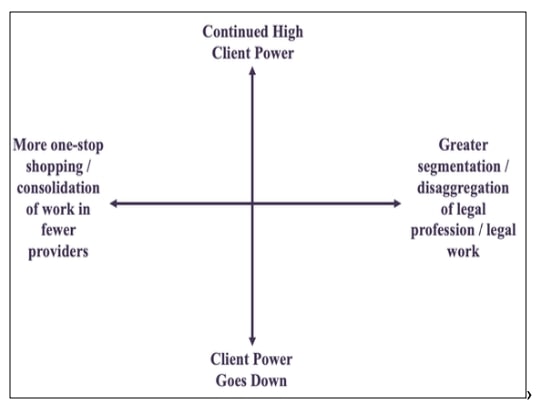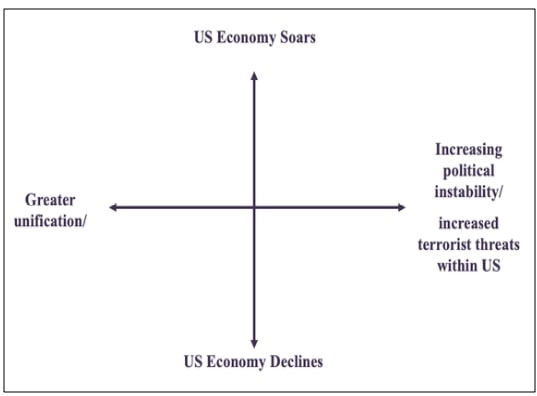Posted on September 22, 2020 by Susan Lambreth
In Part 1 of this series, we discussed how practice groups must rethink their strategy to position themselves in the emerging post-pandemic market and formulate quarter-by-quarter implementation strategies that continue their Group’s forward momentum. In Part 2, we focused on how to develop compelling priorities for your practice group. In addition to short-term, quarter-by-quarter plans, you also need a long-term strategy. For this, we’ll take a look at using scenario planning.
Scenario planning has been used since the 1950s when Herman Kahn of the RAND Corporation employed it with the US military. But Royal Dutch Shell is credited with pioneering this strategic decision-making methodology in business, which prepared them for the energy crisis of the 1970s.
A recent Harvard Business Review article, Learning from the Future, defines scenario planning as a method that “uses stories about alternative futures to challenge assumptions and reframe perceptions of the present.” Scenario planning is one of many “strategic foresight” tools, which do not predict the future but rather, take known facts about the environment and develop educated hypotheses about what could happen. Then, using scenarios, planners can imagine the future in a variety of ways so they can formulate plausible responses.
So, how do these concepts apply in a law firm? Scenario planning can help your firm dynamically identify and mitigate future risks, as well as capitalize on emerging opportunities. Here are the steps and examples of what it could look in a practice group. You will undoubtedly think of others.
Identify the Impacts
The first step is identifying macro and micro forces that may shape future market and operating conditions. For law firms, some of the most significant forces might include:
Consider the Possible Interactions
The next step involves considering how these drivers might interact. The charts below illustrate hypothetical examples of a scenario planning session. After you have identified the key forces that could impact the market, you map out pairs to examine the interplay between them. For example, in Chart 1 below, consider the impact of the combination of:
In this (already occurring) scenario, an obvious impact is the proliferation of providers taking small pieces of work currently handled by law firms. You would continue this exercise with various iterations of the drivers that seem most likely.
Outline Possible Future Scenarios and Formulate Strategies
The third step is to identify a number of plausible futures. Of course, you can’t know precisely which future scenarios are most likely and which are rather unlikely. After all, in 2019, would any of us have imagined a worldwide pandemic would shut down much of the global economy? Still, as you determine approaches that may work for each scenario, you often see there are some common strategies that your firm could apply across several of the envisioned futures. As you analyze these strategies further vis-a-vis your present models and your firm and practice group capabilities, the nascent beginnings of a truly strategic plan will start to take shape. Use the results of this planning to determine how to modify your present model to prepare for one or more of these possible futures.
Scenario Planning in Practice
To look at a concrete example of how your strategic planning sessions would work, start by selecting a diverse group of participants within the Practice Group. The group should include not just partners but also some associates and allied professionals across different areas of expertise and experience. You would brainstorm possible impacts if the uncertainties in the chart occurred. For example, looking at Chart 2:
Now ask: How would this affect your Practice Group? For example:
Similarly, looking at Chart 1 again, if your firm is not one of the largest in the country, either end of the horizontal axis would pose a threat. If the left side of the axis is more likely, the firm might consider merging. Or it could partner with an ALSP, or, alternatively, create its own. And, to make things even more interesting, the two ends of the horizontal axis are not necessarily mutually exclusive.
As you consider both your short- and long-term plans for the remainder of 2020 and into 2021, scenario planning can assist in the identification of longer-term trends that could dramatically impact the U.S. legal profession and help your Practice Group prepare for the competitive environment of the future.
Chart 1

Chart 2

About the Author: Susan Lambreth has over 25 years of experience as a consultant to the legal profession. Susan has helped implement effective practice group management at almost 100 firms, including nearly half of the largest firms in the U.S. She regularly teaches leadership and management skills to Practice Group Leaders and other professionals. Susan also assists firms in implementing effective legal project management initiatives. Along with a colleague, Ms. Lambreth co-created the first legal project management certification program in 2010 and launched the first online eLearning courses in legal project management (LPM LaunchPadTM course). Ms. Lambreth is the author of three books on practice group management as well as three on legal project management.